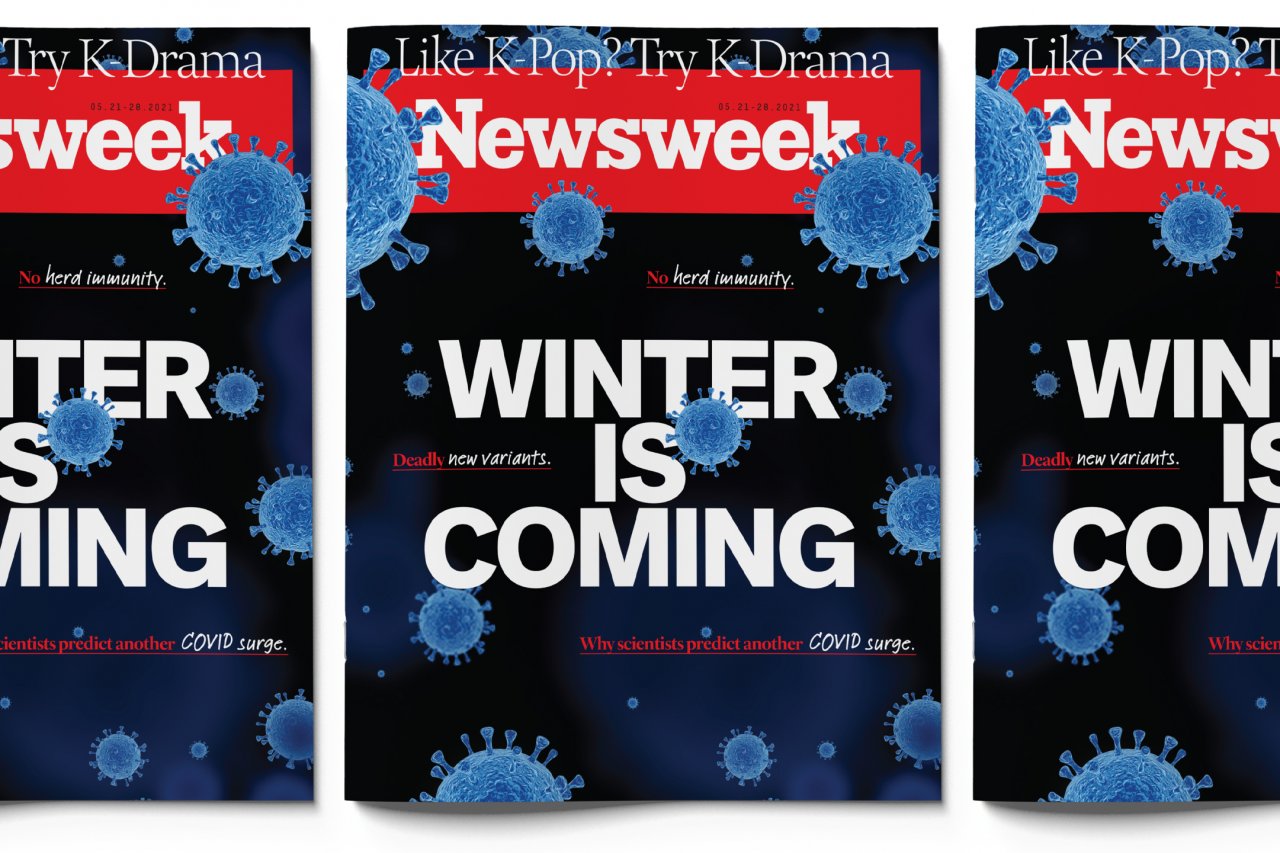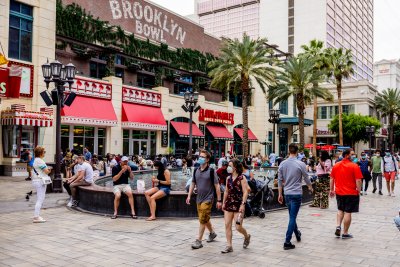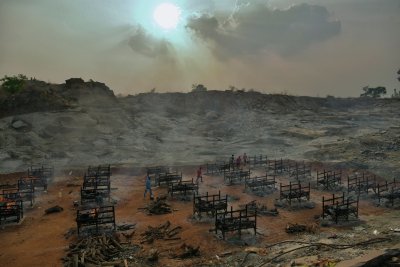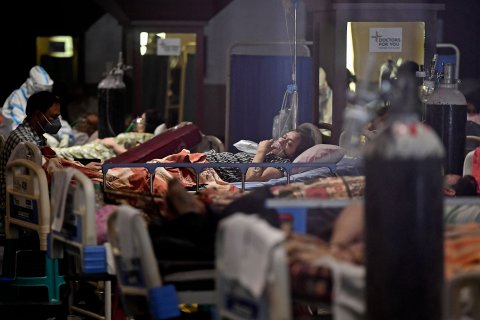BY FRED GUTERL

As India descended into a COVID-19 tragedy that dwarfed anything the country had experienced in the pandemic so far, with hospitals inundated, oxygen supplies short and vaccines reportedly being stolen from warehouses, American politicians thousands of miles away were clamoring to end pandemic restrictions.
Representative Jim Jordan railed at Dr. Anthony Fauci in the House chambers, "You don't think Americans' liberties have been threatened in the last year, Dr. Fauci? They've been assaulted!" Alabama Governor Kay Ivey told Fox News, "We have been at this for more than a year now, and we have simply got to move forward. Endless government mandates are not the answer."
Many Americans are eager to invite friends for a barbeque, belly up to a crowded bar, attend concerts and eat dinner in popular restaurants. Texas and Florida opened beaches and bars in early May. The mayor of New York City, a year after its catastrophic outbreak, announced a lifting of restrictions on businesses would begin on July 1, only to be one-upped by the governors of New York, New Jersey and Connecticut, who moved the date up to May 19. As vaccinations reduce the virus' ability to spread, new cases are now expected to begin dropping exponentially. The summer of love is at hand.
But the pandemic is not over. In the U.S., the nation is still divided in its willingness to accept vaccines or heed precautions against infection. Vaccination rates have peaked and herd immunity now seems unlikely before next winter, almost guaranteeing that pockets of people will remain vulnerable to the coronavirus in the fall, as the cold weather closes in. So will millions of people around the world, who are still vulnerable to infection and have little prospect of getting shots anytime soon.
The coronavirus will continue to circulate widely for months, giving it plenty of opportunities to mutate into troublesome new forms that chip away at the effectiveness of vaccines. The prospect that dangerous new variants will trigger fresh outbreaks—with the accompanying lockdowns, travel restrictions and calls for social distancing and mask-wearing—is a dark cloud over hopes of a return to pre-pandemic normal in 2021 and 2022.
If the first phase of the pandemic was characterized by the clear and present danger of a pandemic virus to more than 7 billion people whose immune systems were totally unprepared for the new pathogen, the second phase we're entering now is full of ambiguity, uncertainty and division.
Public-health messages in the U.S. have been confusing at times. The Centers for Disease Control's revised guidance for masking and distancing comes with a color-coded chart. Scientists and public-health officials celebrate the considerable progress the U.S. has made in its battle against COVID-19 but insist that the U.S. is not yet out of the pandemic woods. "We're by no means in a post-pandemic phase that some sections of America would wish we were," says John Moore, a virologist at Cornell's Weill Medical College, echoing a common sentiment.Ali Mokdad and colleague Catherine Wetmore.COURTESY OF IHMEDr.
When Dr. Fauci announced at the end of 2020 that vaccines would be distributed in the spring, he was optimistic that the U.S. would achieve herd immunity—a level of immune resistance in a population that eliminates, or sharply curtails, the virus' ability to spread—by the fall. "If we do it correctly, we could have 70 percent-to-85-percent of the population vaccinated. When that occurs, there will be an umbrella of protection over the entire country that the level of virus will be so low that you will essentially have been able to establish herd immunity," Fauci told WebMD in December.
It's now clear that this is not likely to happen.
In February, epidemiologist Ali Mokdad and his colleagues at Institute for Health Metrics and Evaluation, a non-profit research group in Seattle, were sifting through data that his group collects from all over the world and uses to make mathematical simulations of how things like seasons, mask-wearing and vaccinations will affect the course of the pandemic. "We were looking at these numbers and were like, 'Oh, no. No'," he recalls.
That night, Mokdad couldn't sleep. He called his mother in Lebanon, who is in poor health and whom he hasn't seen in a year and a half; he decided that night to buy a ticket and go visit her, because he now thinks it may be his last chance to see her for a while. "There will be lockdowns next winter," he says. "Travel will be restricted. We are in a bad position."
The calculations that upset Mokdad suggested that herd immunity was not in the offing in the U.S. "We're not going to reach herd immunity by winter," he says. "The math doesn't add up."
For one thing, children under the age of 12 won't be eligible because vaccines for them won't receive emergency-use authorizations from the FDA in time to be administered before the end of the year. And of course, not all adults who are eligible will roll up their sleeves. Surveys suggest that the number of adults who plan to refuse a vaccine remains stubbornly at about 30 percent. IHME's model assumes that 12-to-15 year-olds will be vaccinated in time with refusal rates of 30 percent, but could be more risk-averse with their children than themselves.
A 'Universal Vaccine' May Soon Protect Against All Coronaviruses
Vaccine uptake has already slowed. The 7-day average peaked on April 11 at 3.3 million doses per day and is dropping fast, according to the CDC. Surveys and interviews show a variety of reasons: people are busy, lack a sense of urgency about COVID-19, have safety concerns about vaccines, distrust health officials, subscribe to conspiracy theories that exaggerate the risks of vaccines and downplay the risks of COVID-19, to name a few. IHME expects about 200 million to 225 million Americans will be vaccinated by the fall.
Falling short of herd immunity is not likely to be problem this summer, when people naturally move outdoors, where breezes tend to carry the airborne coronavirus harmlessly away; new cases will likely continue to drop, and a nation of cloistered citizens will re-acquaint themselves with the joys of socializing unfettered by masks and social distance.
The worry is what happens when cool weather drives everyone back into crowded rooms, where viral particles tend to collect like cigarette smoke, raising exposure to the virus. That's why, to keep the amount of virus in circulation at low levels, vaccination levels have to be higher in winter than they in summer—85 percent would be about right, says Mokdad.
"What many people don't understand is that the herd immunity required to contain a virus like COVID-19 is much lower in summer," he says. "It requires higher immunization coverage during winter, simply because the virus is circulating [at] much higher [levels]. That's the biggest problem we'll face."
Come winter, pockets of vaccine-hesitant people in the U.S. will still have no immune protection against SARS-CoV-2 (also called SARS2), the virus that causes COVID-19. They could unwittingly serve as a welcome party for variants that originate in the U.S. or abroad, including those that can evade protection that more than 100 million Americans have already acquired through vaccinations. With vaccination programs just getting started in many countries, variants will likely make trouble for many months, perhaps years. Pedestrians walk along the Linq Promenade shopping area in Las Vegas, Nevada, U.S., on Saturday, May 1, 2020.ROGER KISBY/BLOOMBERG/GETTY
Pedestrians walk along the Linq Promenade shopping area in Las Vegas, Nevada, U.S., on Saturday, May 1, 2020.ROGER KISBY/BLOOMBERG/GETTY Burning pyres of the victims who died of Covid-19 coronavirus are pictured at an open air crematorium set up for the coronavirus victims inside a defunct granite quarry on the outskirts of Bangalore on May 1, 2021.MANJUNATH KIRAN/AFP/GETTY
Burning pyres of the victims who died of Covid-19 coronavirus are pictured at an open air crematorium set up for the coronavirus victims inside a defunct granite quarry on the outskirts of Bangalore on May 1, 2021.MANJUNATH KIRAN/AFP/GETTY
 Pedestrians walk along the Linq Promenade shopping area in Las Vegas, Nevada, U.S., on Saturday, May 1, 2020.ROGER KISBY/BLOOMBERG/GETTY
Pedestrians walk along the Linq Promenade shopping area in Las Vegas, Nevada, U.S., on Saturday, May 1, 2020.ROGER KISBY/BLOOMBERG/GETTY Burning pyres of the victims who died of Covid-19 coronavirus are pictured at an open air crematorium set up for the coronavirus victims inside a defunct granite quarry on the outskirts of Bangalore on May 1, 2021.MANJUNATH KIRAN/AFP/GETTY
Burning pyres of the victims who died of Covid-19 coronavirus are pictured at an open air crematorium set up for the coronavirus victims inside a defunct granite quarry on the outskirts of Bangalore on May 1, 2021.MANJUNATH KIRAN/AFP/GETTYStaying Ahead of Evolution
To attribute the uncertainty about the next year or two of the pandemic to this or that variant is to miss the complex and dynamic nature of our battle with the virus. The variants are only a snapshot in a continuous story of SARS2 adapting to changing circumstances.
When the pandemic broke more than a year ago, scientists began to track the virus' evolution. They took virus samples, sequenced their genetic codes and shared them with one another in databases. The most prominent, called GISAID, holds the genome sequences of more than 1.4 million SARS2 viruses sampled from 172 countries. The important question is, which ones should we worry about?
Answering that question falls in part to Bette Korber, a computational biologist at Los Alamos National Laboratories in New Mexico. Prior to the pandemic, she worked for decades on AIDS, the ailment caused by HIV, a virus that mutates far more readily than SARS2; a result of these efforts is an AIDS vaccine now in clinical trials. When the pandemic struck, Korber put her retirement plans on hold and instead now works long days sifting through the influx of SARS2 genomes.
Public health officials reassured the public in the early days of the pandemic that SARS did not mutate quickly, which is technically true. The virus has a genetic mechanism that "proof reads" copies of itself made during replication, greatly reducing the rate at which it otherwise would mutate. But SARS2, like HIV and influenza, is an RNA virus, which means it is no slouch in the change department. SARS2 has been making up for its slowness in mutating with sheer volume: The more than 100 million infected people give it a big evolutionary runway to evolve into new forms.
Beginning in March 2020, Korber began building tools to track the evolution of the virus as it spreads, allowing scientists to construct a gigantic family-tree of viral offspring and identify those variants that thrive. The next step is to find out what characteristics they possess that make them win against other variants in the daily battle for survival.
The effort paid off early. In the spring of 2020, she and her colleagues used these tools to identify a "variant of concern" known as D614G, nicknamed "Doug," that was increasing in relative frequency compared to the original ancestral form that first arose in Wuhan. Three months later, it had become the world's dominant strain. Laboratory studies uncovered mutations that made it more infectious.
COVID-19 Could Increase Dementia, Other Brain Disorders for Decades to Come
By November 2020, the role of variants in the pandemic was becoming widely appreciated among public-health officials and the public. "The more you look, the more you find, and the more you realize the implications," says Cornell's Moore.
Now that a year has passed since Doug was first identified, a growing number of people, either through vaccination or prior infection, can now summon effective immune responses against this variant. The same goes for other variants, such as B117, the so-called UK variant, which recently punished Michigan, has become the dominant strain in the U.S. and elsewhere and plays a big role in India's outbreak as well.
The rise of immune resistance in the population is a roadblock to the coronavirus, but it is also a challenge that new variants could potentially overcome. A variant with the ability to infect vaccinated people will have a big evolutionary advantage over its rivals. The South African variant, B1351, and the Brazil variant, P1, have some ability to evade the immune protection of current vaccines; B1351, for instance, is known to blow right past the defenses of AstraZeneca's. As the coronavirus butts up against populations of fully-vaxxed people, it will continue to look for a way in.
Vaccine-resistant variants have already gained a foothold in the U.S. Strains of the virus found in California and Oregon have some of the same mutations as P1. Variants in the southeastern U.S. have mutations also found in B1351. As more and more people are vaccinated effectively against B117 and others, those strains that can resist vaccines will gain a relative evolutionary advantage and may come to predominate. New variants will also continue to emerge.
"We human beings have to be clever enough to stay ahead of that adaptation," says Korber. "So far we have these incredible vaccines that are effective even as the virus is beginning to explore some immunological resistant mutations. That has to be resolved in the laboratory. It has to be understood. Over the next year or two we're going to have to be trying vaccines that address the variants and maybe boosters, and we have to evolve our response."
It's not likely that a future SARS2 variant will hit the genetic jackpot and turn the clock back to January 2020, when the world's 7 billion people were immunologically naïve to the coronavirus; chances are, vaccines would provide some protection against even a seriously challenging variant. Bette Korber and others will be watching, just in case the improbable happens.
The more likely scenario is that variants keep the embers of pandemic burning longer than anyone would like. The recent case of Chile offers a sobering case. Despite a robust vaccination effort that has reached more than 40 percent of the population, Chile experienced its worst outbreak yet. The crisis is thought to be due in part to complacency among people who are only partially vaccinated, who relax on precautions such as social distancing and mask wearing. But the presence of the P1 variant, which has some ability to evade vaccines, may also play a role. The situation in Chile is a warning: a partially-vaccinated population is less safe against potentially dangerous variants.
 Covid-19 positive patients inside a banquet hall temporarily converted into a covid care centre in New Delhi on April 29, 2021.TAUSEEF MUSTAFA/AFP/GETTY
Covid-19 positive patients inside a banquet hall temporarily converted into a covid care centre in New Delhi on April 29, 2021.TAUSEEF MUSTAFA/AFP/GETTYWorst Case
Suppressing the amount of virus in general circulation is the best way to protect against variants--it makes outbreaks easier to quickly identify and contain, and reduces opportunities for the virus to mutate. A variant can still enter the country from abroad, but it gives public health authorities a better chance to respond.
Moore puts the matter this way: "If a significant fraction of America simply refuses to be vaccinated because they've drunk the Kool-Aid and get their information from QAnon and crazy Republican politicians, then that compromises the entire nation's ability to return to normal."
Ultimately, however, the safety of the U.S. is wrapped up in the status of the world population. The more people the coronavirus infects, the more room it has to mutate into dangerous new forms. "The more we can limit the spread of the virus, the less evolutionary space it has," says Korber. "So vaccination and continued good behavior with masks and social distancing is the way we can limit the playing field for the virus in terms of its evolutionary potential."
It's in the interests of the U.S. and all nations to get the rest of the world vaccinated as quickly and completely as possible. Those efforts are behind schedule, however. COVAX, the international organization that is aiming to vaccinate 20 percent of the poorest nations by year's end, has had setbacks in manufacturing and distribution related to the outbreak in India.
COVAX's problems started earlier, however. When wealthy nations were cutting deals with vaccine makers last year, COVAX was still arranging financing. Had the organization gotten more support ahead of time, it would have saved valuable time. "I hope when we come out of this, we keep in mind that with global warming, desertification, intense urbanization and population growth, we are certain to have more outbreaks," says Dr. Seth Berkley, CEO of Gavi, an organization that makes vaccines available to developing countries, and a leader of COVAX. "And if we know that's true, then let's prepare for it."
Another important measure would be to establish formal mechanisms for keeping watch over new viruses and variants and supporting virologists who track viruses. The $1.7 billion the Biden administration has set aside to find and track variants in the U.S. will help, but containing the virus and preparing for future outbreaks will require a vast international effort.
The outbreak in India, to take only one of many examples, is only 15 hours by plane from Washington, D.C.
No comments:
Post a Comment